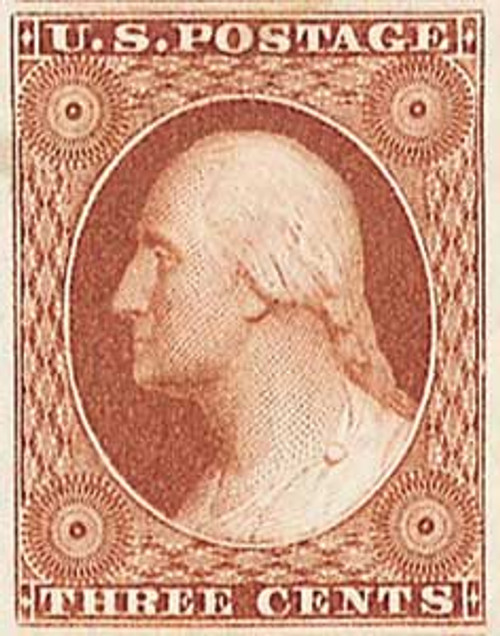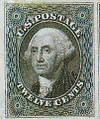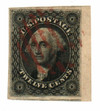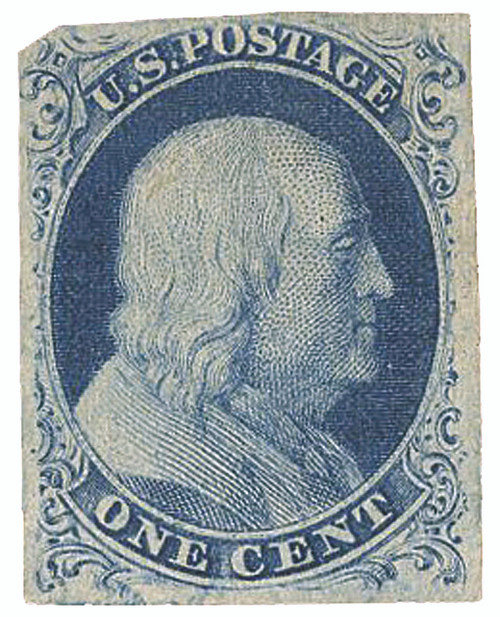
# 17 - 1851 12c Washington imperforate, black
U.S. #17
1851 Washington
- First 12c U.S. postage stamp
- No major varieties known
- Singles on cover are scarce
- Bi-sects are greatly valued on cover
- An extremely rare minor variety exists printed on both sides (only four known)
Stamp Category: Definitive
Series: 1851-57 Issue
Value: 12c
Issue date: July 1, 1851
Earliest documented use: August 4th, 1851
Printed by: Toppan, Carpenter, Casilear & Co.
Quantity printed: 2,500,000 (estimate)
Format: Printed in sheets of 200 stamps, divided into two panes of 100 each, in rows of 10x10
Printing Method: Engraved, flat plate press
Perforations: Imperforate
Color: Gray black
Why the stamp was issued: The 12c Washington stamp was issued to pay the postage on heavier domestic letters and packages. Two stamps could pay four times the first-class rate under 3,000 miles (for 1.5-to 2 ounces) or two times the rate over 3000 miles (for ½ -1 ounce.) A pair was most often used to pay the 24c postage to England.
The stamp was often cut in half (bisected) diagonally or horizontally to pay the 6c domestic rate to the West coast or double the 3c domestic rate up to 3,000 miles. These bisects are valued on cover because they document the stamps’ genuine postal use.
About the printing: The design is engraved on a die – a small, flat piece of steel. The design is copied to a transfer roll – a blank roll of steel. Several impressions or “reliefs” are made on the roll. The reliefs are transferred to the plate – a large, flat piece of steel from which the stamps are printed. The 12c stamps were printed very closely together, so most have small margins.
About the design: George Washington’s portrait on the #17 is based on a painting by artist Gilbert Stuart, who created many portraits of the president.
Special design details: Elaborate rosettes appear in each corner. The remainder of the background framing the vignette’s medallion is an intricate geometric pattern (mosaic).
About the 1851-57 Series: On July 1, 1851, 1c, 3c, and 12c stamps were issued. These new stamps met the reduced postal rates passed by act of Congress on March 3, 1851. U.S. #1 and #2 were demonetized. Later changes due to the Act of March 3, 1855 led to 10c (1855) and 5c (1856) additions to the series. Perforated stamps of the same designs (plus three new designs) were issued in 1857 as part of the Series of 1857-61.
History the stamp represents: America’s first two postage stamps were issued in 1847. Rates were determined by the weight and distance the letter was sent. Letters mailed 300 miles or less were 5¢ per half ounce; while those mailed over 300 miles were 10¢ per half ounce. Postage could be paid by the sender at the time the letter was mailed, or by the addressee upon receipt.
These stamps and rates remained in use until 1851, when Congress reduced postal rates. These new rates created the need for new denominations. The first stamps issued to meet the lower rates were issued on July 1, 1851. The new 1¢ stamp was used on newspapers, circulars, and “drop letters” (letters mailed to the same town.) The single letter rate, based on a half-ounce, was changed to 3¢ for mail sent up to and including 3,000 miles (except for drop letters.) Mail exceeding this distance was lowered to 6¢ and two of the new 3c stamps could be used to pay postage to the West Coast. Besides the 1c and 3c stamps, a 12c stamp was issued.
Prepayment was still optional. If postage was paid by the addressee upon receipt, the rate was higher. Due to increased collect rates, the use of postage stamps was greatly stimulated. The cheaper rates were attractive to Americans, too. Prepayment of postage with stamps was made mandatory January 1st, 1856. Requiring people to pre-pay postage lightened the burden on postal clerks and allowed mailers to simply drop their letters in the post office mail slot, rather than waiting in long lines.
U.S. #17
1851 Washington
- First 12c U.S. postage stamp
- No major varieties known
- Singles on cover are scarce
- Bi-sects are greatly valued on cover
- An extremely rare minor variety exists printed on both sides (only four known)
Stamp Category: Definitive
Series: 1851-57 Issue
Value: 12c
Issue date: July 1, 1851
Earliest documented use: August 4th, 1851
Printed by: Toppan, Carpenter, Casilear & Co.
Quantity printed: 2,500,000 (estimate)
Format: Printed in sheets of 200 stamps, divided into two panes of 100 each, in rows of 10x10
Printing Method: Engraved, flat plate press
Perforations: Imperforate
Color: Gray black
Why the stamp was issued: The 12c Washington stamp was issued to pay the postage on heavier domestic letters and packages. Two stamps could pay four times the first-class rate under 3,000 miles (for 1.5-to 2 ounces) or two times the rate over 3000 miles (for ½ -1 ounce.) A pair was most often used to pay the 24c postage to England.
The stamp was often cut in half (bisected) diagonally or horizontally to pay the 6c domestic rate to the West coast or double the 3c domestic rate up to 3,000 miles. These bisects are valued on cover because they document the stamps’ genuine postal use.
About the printing: The design is engraved on a die – a small, flat piece of steel. The design is copied to a transfer roll – a blank roll of steel. Several impressions or “reliefs” are made on the roll. The reliefs are transferred to the plate – a large, flat piece of steel from which the stamps are printed. The 12c stamps were printed very closely together, so most have small margins.
About the design: George Washington’s portrait on the #17 is based on a painting by artist Gilbert Stuart, who created many portraits of the president.
Special design details: Elaborate rosettes appear in each corner. The remainder of the background framing the vignette’s medallion is an intricate geometric pattern (mosaic).
About the 1851-57 Series: On July 1, 1851, 1c, 3c, and 12c stamps were issued. These new stamps met the reduced postal rates passed by act of Congress on March 3, 1851. U.S. #1 and #2 were demonetized. Later changes due to the Act of March 3, 1855 led to 10c (1855) and 5c (1856) additions to the series. Perforated stamps of the same designs (plus three new designs) were issued in 1857 as part of the Series of 1857-61.
History the stamp represents: America’s first two postage stamps were issued in 1847. Rates were determined by the weight and distance the letter was sent. Letters mailed 300 miles or less were 5¢ per half ounce; while those mailed over 300 miles were 10¢ per half ounce. Postage could be paid by the sender at the time the letter was mailed, or by the addressee upon receipt.
These stamps and rates remained in use until 1851, when Congress reduced postal rates. These new rates created the need for new denominations. The first stamps issued to meet the lower rates were issued on July 1, 1851. The new 1¢ stamp was used on newspapers, circulars, and “drop letters” (letters mailed to the same town.) The single letter rate, based on a half-ounce, was changed to 3¢ for mail sent up to and including 3,000 miles (except for drop letters.) Mail exceeding this distance was lowered to 6¢ and two of the new 3c stamps could be used to pay postage to the West Coast. Besides the 1c and 3c stamps, a 12c stamp was issued.
Prepayment was still optional. If postage was paid by the addressee upon receipt, the rate was higher. Due to increased collect rates, the use of postage stamps was greatly stimulated. The cheaper rates were attractive to Americans, too. Prepayment of postage with stamps was made mandatory January 1st, 1856. Requiring people to pre-pay postage lightened the burden on postal clerks and allowed mailers to simply drop their letters in the post office mail slot, rather than waiting in long lines.


















